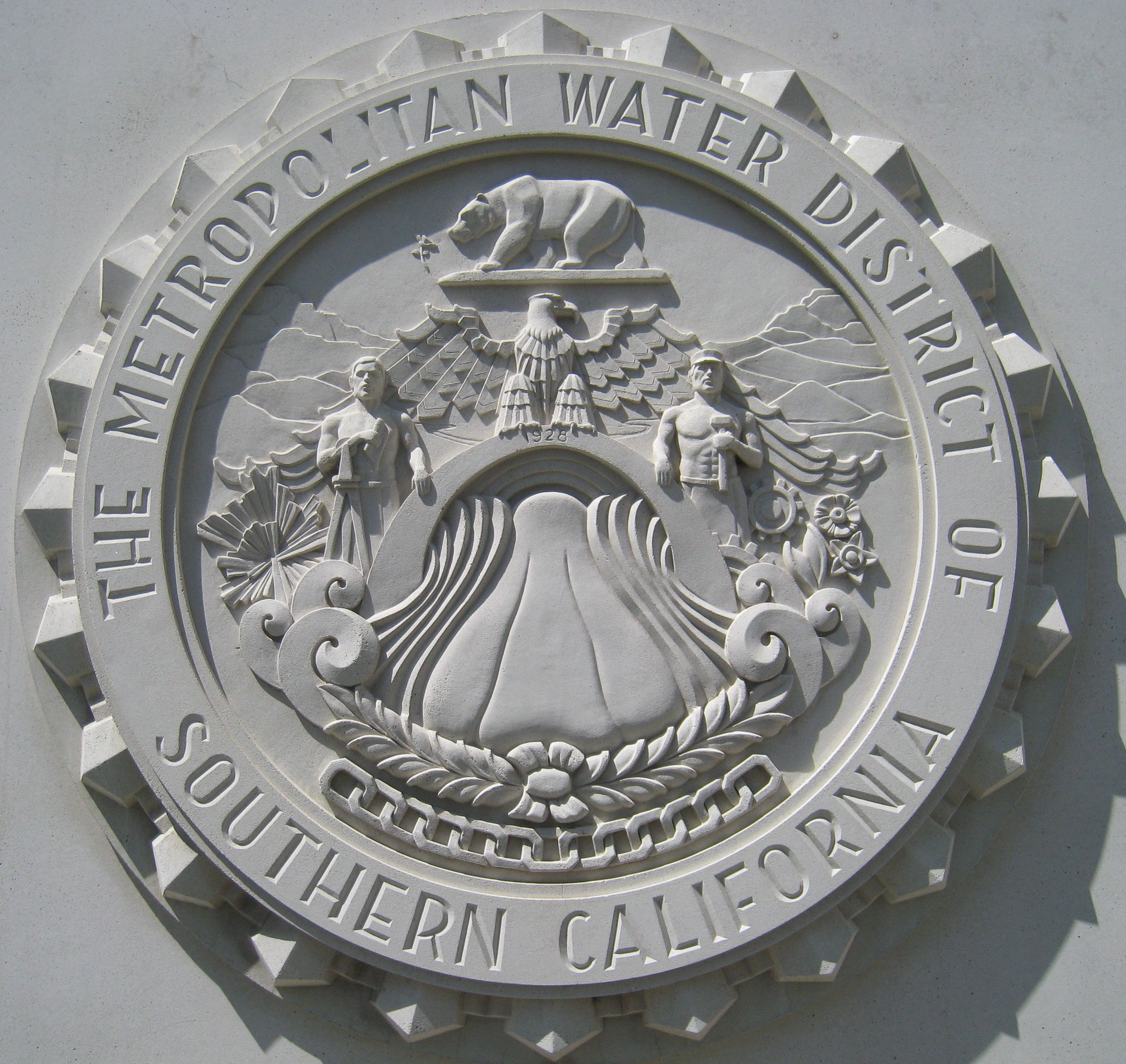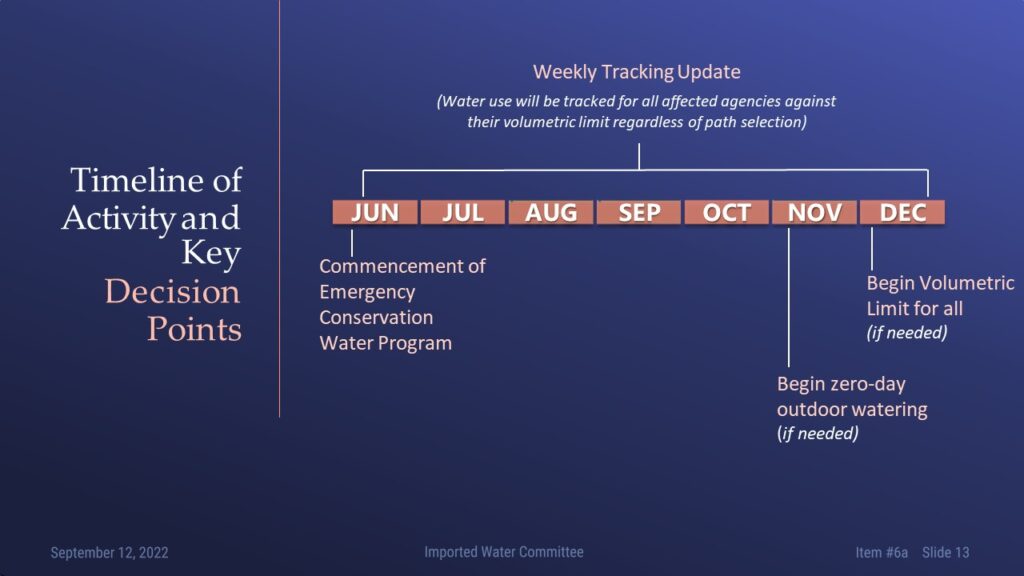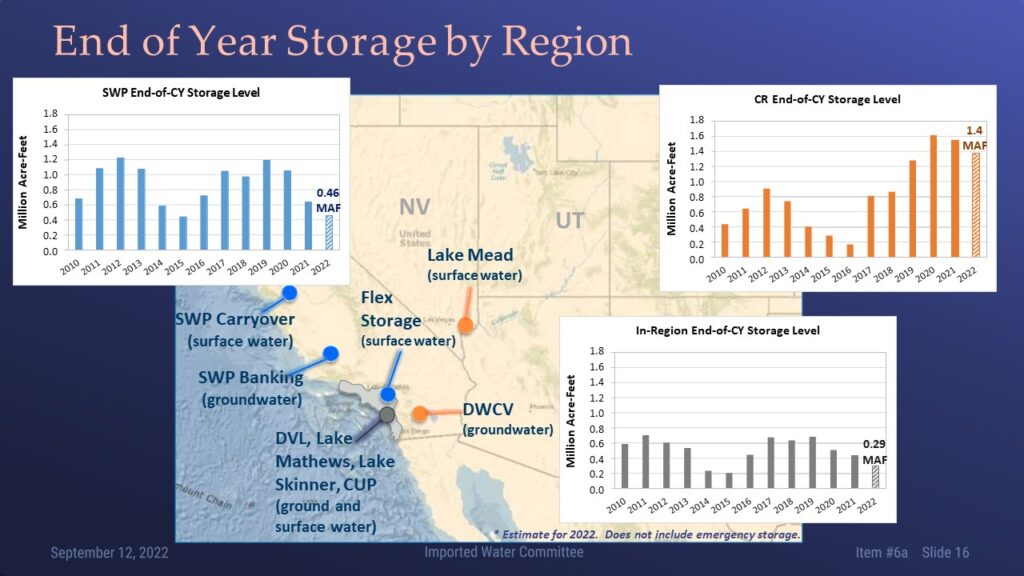Storage supplies not evenly distributed throughout the service area; Changes in accounting on the Colorado River could further impact supplies
At the September meeting of Metropolitan’s Imported Water Committee, staff updated committee members on Metropolitan’s water supplies and demand, the emergency water conservation program, and the outlook for Metropolitan’s Colorado River supplies.
Metropolitan’s water supplies
Supply and demand
Noosha Razavian, an associate resource specialist on the resource planning team, began by noting that extreme weather conditions inside and outside Metropolitan’s service area have impacted supply and demand conditions. Monsoonal weather throughout the Southwest has raised Lake Mead by about 3 feet compared to the end of July. It has also resulted in changes to the current higher priority water use adjustment estimates, which shifted from around negative 91,000 acre-feet last month to negative 63,000 acre-feet this month. Additionally, the record-setting heatwave affecting Southern California these past few weeks has also impacted demand throughout their service area.
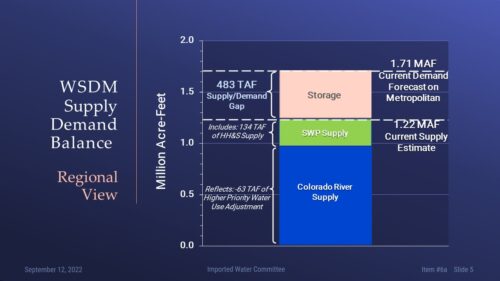 The current supply estimate is approximately 1.22 million acre-feet; that includes the current Colorado River Aqueduct estimate adjusted for the higher priority water use, the 5% State Water Project Table A allocation, 134,000 acre-feet of human health and safety supplies, and the latest estimate for transfer supplies. Ms. Razavian noted that the human health and safety supplies include the additional 1300 acre-feet of human health and safety water that DWR recently approved in response to the Upper Feeder shutdown.
The current supply estimate is approximately 1.22 million acre-feet; that includes the current Colorado River Aqueduct estimate adjusted for the higher priority water use, the 5% State Water Project Table A allocation, 134,000 acre-feet of human health and safety supplies, and the latest estimate for transfer supplies. Ms. Razavian noted that the human health and safety supplies include the additional 1300 acre-feet of human health and safety water that DWR recently approved in response to the Upper Feeder shutdown.
Current demand is projected to be around 1.71 million acre-feet, leaving a gap of about 483,000 acre-feet. The gap will be filled by storage withdrawals, water purchases, and regional conservation efforts to reduce demand.
Colorado River Supplies
The Bureau of Reclamation’s 24-month study, released in August, determines the operating conditions of the Colorado River for the next calendar year. Based on this study, USBR declared the first-ever level 2A shortage for the calendar year 2023. For the lower basin, this means Arizona, Nevada, and Mexico will also be required to make Drought Contingency Plan (DCP) contributions next year.
However, under a level 2A shortage, California will not need to make DCP contributions in 2023. Supplies to Metropolitan will not be curtailed, and Metropolitan will have full access to its Intentionally Created Surplus (ICS) in 2022 to fill the Colorado River Aqueduct.
Emergency water conservation program
Metropolitan’s Emergency Water Conservation program began on June 1 for those member agencies dependent on the State Water Project. The program has two paths for compliance. Three member agencies are under path one, while the remaining agencies are under path two. No penalties have been issued for any agencies thus far in the program. Path one compliance requirements do remain limited to one-day-a-week outdoor watering through October.  The graphic on the slide below shows the water use of the State Water Project-dependent areas for the first three months of the program. The orange line is the demand projection from April this year; the dashed line shows the monthly volumetric limits for June through December. Ms. Razavian noted that actual demand for June, July, and August fell below the projected demand and the volumetric limits for each of those respective months.
The graphic on the slide below shows the water use of the State Water Project-dependent areas for the first three months of the program. The orange line is the demand projection from April this year; the dashed line shows the monthly volumetric limits for June through December. Ms. Razavian noted that actual demand for June, July, and August fell below the projected demand and the volumetric limits for each of those respective months.
The chart below compares the data from the first three months for the State Water Project-dependent areas for the entire seven-month period of June through December, compared to the total 2020 volumetric limit. As of August 31, the State Water Project-dependent areas have used around 104,000 acre-feet of water and are currently trending about 3% below the 2022 volumetric limit.
For the remainder of the year, a total ban on outdoor watering for Path One agencies is still yet to be determined for November; staff will notify affected agencies at least 30 days in advance and report the decision to the board.
Additionally, the general manager retains the discretion to move all member agencies to volumetric limits beginning December 1.
The cumulative use by State Water Project-dependent areas and the performance by each member agency participating in the emergency water conservation program can be tracked at https://www.mwdh2o.com/how-we-plan/drought.
Planning for a dry 2023: Constraints with stored supplies
Staff currently projects ending the calendar year with approximately 2.1 million acre-feet of region-wide dry year storage. While, at first glance, it might appear there are plenty of reserves for the next year, those supplies are not available to all throughout Metropolitan’s service area.
The slide below breaks down the end-of-year storage, with State Water Project storage in blue, Colorado River in orange, and in-region storage in gray.
The State Water Project storage draws from several accounts, including carryover, groundwater banking, and flexible storage, and is projected to end the year at roughly 460,000 acre-feet. Metropolitan will draw from the Lake Mead ICS and the DWCV Advanced Delivery Account on the Colorado River and projects to end the year with around 1.4 million acre-feet. In-region storage, which includes Diamond Valley Lake, Lake Matthews, Lake Skinner, and the Conjunctive Use Program, is projected to end the year with around 290,000 acre-feet.
“However, not all of the projected 2.1 million acre-feet of storage will be accessible to Metropolitan in 2023,” said Ms. Razavian. “If we assume a 5% state water project allocation for 2023, the maximum take capacities for each of the three regions put real-world constraints on the storage available for Metropolitan to draw upon.”
“For example, although we’ll have almost half a million acre-feet of State Water Project storage, of that 460,000 acre-feet saved, it may be that only 90,000 acre-feet will actually be available for use in 2023. So declining storage supplies, as well as maximum take capacities and operational limitations, have significant impacts on our planning for this next year.”
Ms. Razavian pointed out that the 2.1 million acre-feet is not evenly distributed across the Colorado River, State Water Project, and in-region assets.
“Over half of Metropolitan’s dry year storage supplies will be within our Colorado River supplies next year,” she said. “However, much of the storage in Lake Mead will need to be held back to satisfy DCP contributions and obligations in the coming years. Meanwhile, when we look at our State Water Project and in-region storage accounts, we see relatively low levels of storage remaining, especially when we consider our take capabilities and other obligations. These low levels of storage have thus prompted discussions both internally and with your member agencies on parameters for region-wide allocation in 2023 to help preserve much-needed supplies.”
Next steps
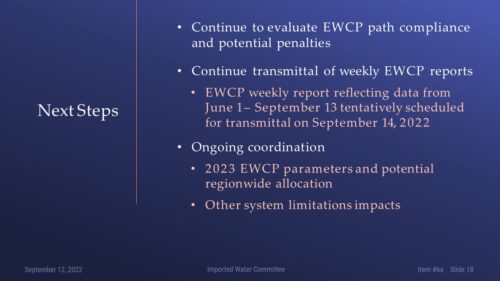 Ms. Razavian says that Metropolitan continues to evaluate each member agency’s compliance and any potential penalties incurred by the member agencies for the emergency water conservation program. They continue to provide monitoring reports weekly on both the member agency website and the Board website.
Ms. Razavian says that Metropolitan continues to evaluate each member agency’s compliance and any potential penalties incurred by the member agencies for the emergency water conservation program. They continue to provide monitoring reports weekly on both the member agency website and the Board website.
“As a reminder, the emergency water conservation program is approved through June 30, 2023,” she said. “So staff is working with the member agencies to determine the appropriate parameters for this program next year, as well as begin the discussions on region-wide mandatory reductions. And lastly, we’ll continue to coordinate with the member agencies and your board on any impacts from system limitations within our service area.”
Discussion highlights
Director Gail Goldberg (San Diego) asked if staff could provide clarification as to the point when the board will be considering a short-term plan of addressing issues for 2023 and 2024. “Is there a separate process? It’s not the Integrated Resources Plan; this is not long-range planning … how are we going to create a plan going forward for the next two years? What’s the process? And when will it start?”
“Typically, what happens when we go into the fall when there’s the greatest uncertainty, particularly in the State Water Project, about what supplies will look like in the next year, we try to give you a sense of the range of supplies coming from the DWR analysis that will affect 2023,” said executive officer and assistant general manager Deven Upadhyay. “Unfortunately, DWR doesn’t do a two-year analysis. So for the second year, we’ll have to make some assumptions about what 2024 might look like. But DWR provides some of that decision support that we then share with you on the range of what the state water project outcomes can look like for this next calendar year. And we then layer on the various things we can pull from to augment that supply in the drier scenarios or the way we can capture the water into storage in the wetter scenarios.”
“Going into this next year, in the scenarios for 2023, where the State Water Project is going to be low, our ability to pull from storage to augment those scenarios is much lower than what it’s been in the last couple of years. So that will then lead to, in the driest of scenarios, of having to continue the emergency conservation programs that the board has already adopted. And it will also lead to an analysis that staff is working on that will show that under some conditions, we may need to go into a broader region-wide allocation plan. So our desire is to show you that analysis as 2023 develops and be able to inform your decision-making on whether you need to pull that trigger or not.”
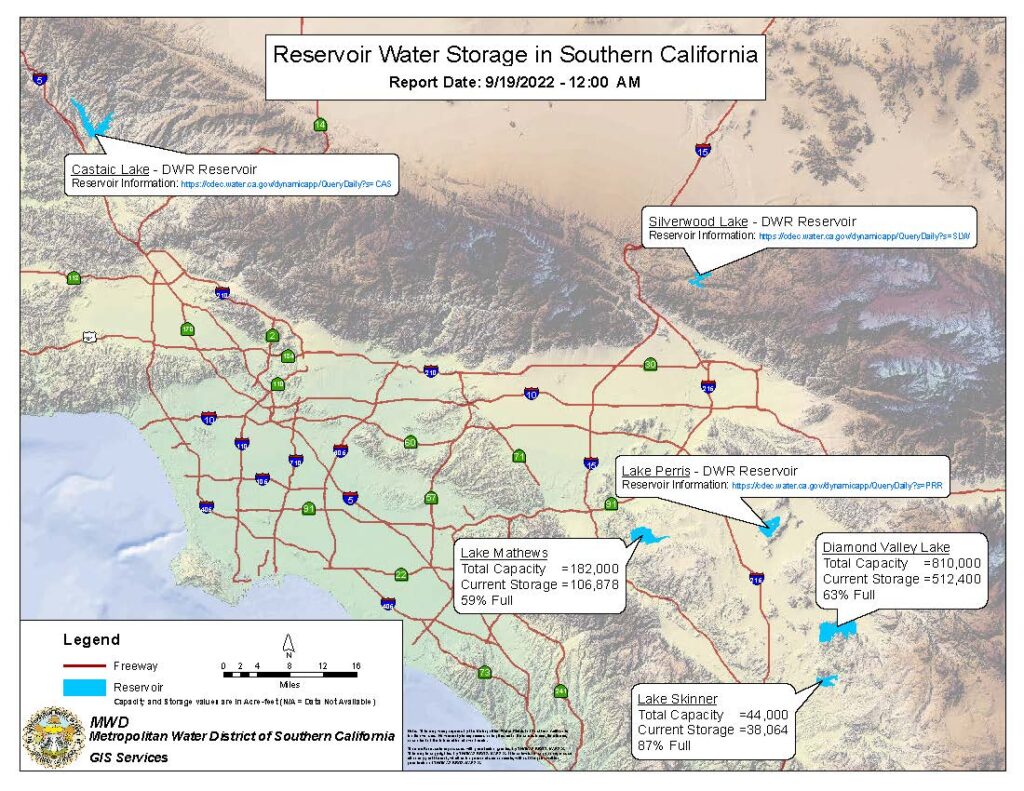 Director Marsha Ramos (Burbank) asked about contingency supplies. Can you give an outline of what those could possibly be?
Director Marsha Ramos (Burbank) asked about contingency supplies. Can you give an outline of what those could possibly be?
“In the springtime, we came to the board, and the board authorized our participation in a pool of contractors on the state water project that would go out and negotiate transfer supplies,” said Mr. Upadhyay. “We ended up getting a very small amount of water through that pool. I think the final numbers are still coming in on the amount of supply we’ll have available from that transfer pool, but it’s in the range of 20-30,000 acre-feet in total.
“So we’re in discussions with folks in the Central Valley on the State Water Project to look at whether additional supplies can be made available next year going into 2023, knowing that even if it were a relatively normal year, we would still benefit from those additional supplies. There might be a scenario where staff recommends that we acquire transfer supplies that would go beyond typical dry scenarios. It doesn’t have to be a 10 or 15% State Water project allocation, which would be pretty low. But it could even be a more normal circumstance, and we would still benefit from acquiring that transfers because we can augment our storage and restock the storage and preparation for another dry year in the future.”
“The reason that’s important is the counterparties, oftentimes ag counterparties, appreciate certainty. The certainty that I mean is to say, if it’s a normal or a wetter year, are you still going to buy the water? Or am I going to be left holding the bag, and we don’t have a deal? So we can provide a little bit more certainty knowing that we can bring a recommendation to you as a board saying we’ll purchase transfer water, not just in the driest of circumstances, but even maybe even in normal years. So that’s the nature of the discussions we’re having going into 2023 that are very different from what we’ve had in previous years.”
COLORADO RIVER OUTLOOK
24-month study: First-ever Tier 2A shortage
Shanti Rosset, program manager with the Colorado River resources group, updated the committee members on the water supply conditions on the Colorado River.
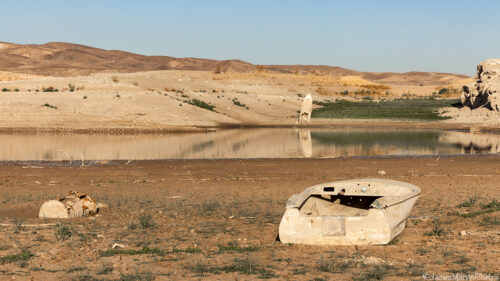
The 24-month study was issued by the Bureau of Reclamation last month. Each year, the 24-month study is used to set the Tier Determinations and operations of Lake Powell and Lake Mead in the Bureau of Reclamation’s) Annual Operating Plan. While the 24-month study forecasts end-of-year reservoir elevations, Ms. Rosset noted that operations are determined by actual elevations in Lake Powell and Lake Mead on January 1 and could change due to precipitation and runoff being more or less than what was forecasted in the 24-month study.
According to the 24-month study results, Lake Mead is forecasted to be in its first-ever Tier 2A shortage. This means Arizona will take a shortage of approximately 21% of its annual apportionment, with Nevada at 8% and Mexico at 7%. In Tier 2A, California is not required to make the DCP contribution, and California does not take shortages. Based on the forecast, Ms. Rosset said that Metropolitan will be able to take delivery of Intentionally Created Surplus next year.
Lake Powell operations
In May of this year, the Interior Department took action to protect Lake Powell after it fell below elevation 3525 for the first time, including releases from reservoirs upstream of Lake Powell, combined with reduced releases from Glen Canyon Dam. “Interior’s announcement stated that actions were designed to protect critical elevations at Lake Powell, and consistent with the May action statement of protecting elevation 3525 at Lake Powell, the August 24 month study has set the annual release from Glen Canyon Dam initially to 7 million acre-feet, the lowest volume permitted under current guidelines.”
Reclamation will evaluate the hydrologic conditions in April next year to determine whether to make balancing releases. However, balancing releases will be limited to protect Lake Powell from declining below elevation 3525 at the end of December 2023.
Actual inflows much less than what was forecasted
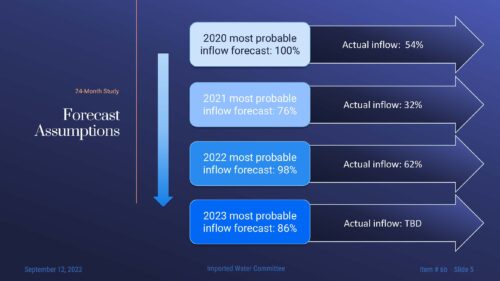 The 24 months study is based on the most probable inflow scenario, which reflects a median hydrologic condition based on the 30-year average, which, unfortunately, includes the very wet 1990s. The elevations of Lake Powell and Lake Mead have experienced a rapid decline over the past three years because actual inflows into the system were well below what was forecast in the most probable inflow scenario.
The 24 months study is based on the most probable inflow scenario, which reflects a median hydrologic condition based on the 30-year average, which, unfortunately, includes the very wet 1990s. The elevations of Lake Powell and Lake Mead have experienced a rapid decline over the past three years because actual inflows into the system were well below what was forecast in the most probable inflow scenario.
“In 2020, the most probable inflow scenario was forecast to be near 100%, but the actual inflow was 54%,” Ms. Rosset said. “In 2021, the most probable inflow scenario was forecast to be 76%, but the actual inflow was just 32%. And this year, the most probable inflow forecast was 98% of the median, but the actual inflow was just 62%. The most probable inflow forecast for 2023 is 86%. Actual inflows for next year won’t be known until late next spring, but water managers have reason to keep in mind that recent inflows have come significantly below the most probable inflow forecasts. In fact, in 2021, the actual inflows were below the minimum probable inflow scenario.”
Possible administrative actions, including re-evaluating beneficial use and adjustments for evaporation and seepage
In June, the Commissioner of the Bureau of Reclamation told the Senate Energy and Natural Resources Committee that 2-4 million acre-feet of additional or conserved water would be needed annually to stabilize the elevations of Lake Powell and Lake Mead and gave the basin states 60 days to come up with a consensus plan to accomplish this. Unfortunately, the basin states did not meet that ambitious goal, even though there were numerous meetings and discussions during that time. When the August 24-month study results were announced, the Interior Department provided an updated analysis of the need for what they called ‘protection volumes’ of between 600,000 acre-feet or 4.2 million acre-feet annually, depending on actual runoff into the system.
When Reclamation announced the August 24-month study, they also identified over a dozen administrative actions that would be immediately initiated to adjust the situation in the reservoirs. “Lake Mead is forecast to fall below elevation 1025 on January one of next year, and this may trigger the reconsultation provision of the 2007 interim guidelines,” said Ms. Rosset. “Consistent with that, Interior announced that it will take administrative actions to define shortage operations below Lake Mead elevation 1025, which are not currently defined in the interim guidelines.”
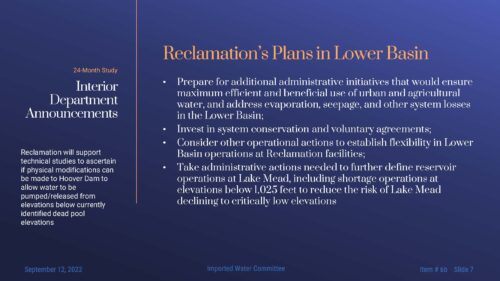 Another potential action of particular importance in the lower basin, and California especially, is the beneficial use of water. “Under a current federal regulation known as part 417, Reclamation has the authority to limit water orders to what is reasonably required for beneficial use,” she said. “The department will be evaluating maximum reasonable and beneficial use for all sectors: municipal, industrial, and agricultural.”
Another potential action of particular importance in the lower basin, and California especially, is the beneficial use of water. “Under a current federal regulation known as part 417, Reclamation has the authority to limit water orders to what is reasonably required for beneficial use,” she said. “The department will be evaluating maximum reasonable and beneficial use for all sectors: municipal, industrial, and agricultural.”
Perhaps of more importance, Interior announced they would be looking into evaporation, seepage, and other system losses in the lower basin. “Applying evaporation losses in the lower basin would mean that California’s Colorado River supply could take a big hit, potentially hundreds of thousands of acre-feet annually,” said Ms. Rosset. “Depending on how the department applies evaporation losses, they could be charged to each contractor based on their use or losses charged to each state. Either way, this could result in a significant and permanent reduction in the amount of Colorado River water that Metropolitan would be entitled to take.”
“There is a lot of focus on the priority system among the irrigation districts, but if Reclamation charged evaporation losses based on a contractor’s consumptive uses, it would mean that even senior rights holders would face big cuts regardless of their priority,” added Ms. Rosset.
No agreement on how to stabilize the system
The basin states have not reached a consensus yet about how to stabilize the system. However, the upper basin states announced a five-point plan that includes no new commitments to conserve water.
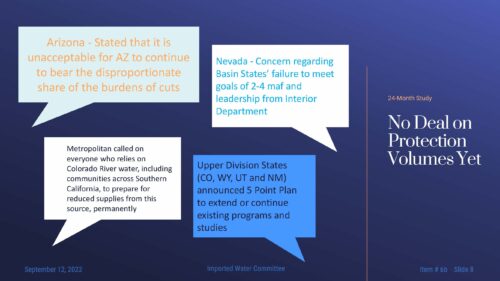 When the basin states didn’t achieve consensus to meet the protection volume goals set by the Commissioner, there was a lot of criticism of California, acknowledged Ms. Rosset. Nevada sent a comment letter criticizing California and the Interior Department’s leadership and failing to meet the goals laid out by the Commissioner in June. Arizona said it had come to the table with a real offer and criticized California for its voluntary and conditional plan, saying it is unacceptable for Arizona to continue to bear the disproportionate share of the burden of cuts. The Colorado River Board of California released a statement that it was disappointed that a deal hadn’t been reached.
When the basin states didn’t achieve consensus to meet the protection volume goals set by the Commissioner, there was a lot of criticism of California, acknowledged Ms. Rosset. Nevada sent a comment letter criticizing California and the Interior Department’s leadership and failing to meet the goals laid out by the Commissioner in June. Arizona said it had come to the table with a real offer and criticized California for its voluntary and conditional plan, saying it is unacceptable for Arizona to continue to bear the disproportionate share of the burden of cuts. The Colorado River Board of California released a statement that it was disappointed that a deal hadn’t been reached.
“Metropolitan’s statement called for everyone who relies on Colorado River water, including communities across Southern California, to prepare for reduced supplies from the source permanently,” said Ms. Rosset. “Metropolitan is continuing to work with other contractors in California to have a voluntary agreement in place next year.”
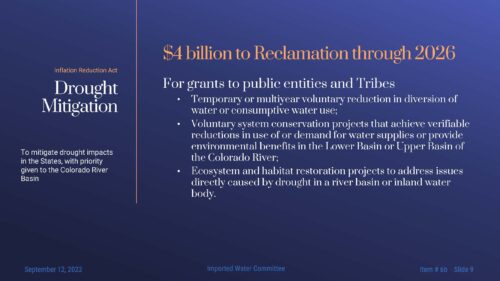 Ms. Rosset noted that $4 billion was included in the inflation Reduction Act for Reclamation to provide funds to public entities and tribes to mitigate drought impacts, with a priority to be given to the Colorado River Basin. The money can be used for temporary or multi-year voluntary reductions in diversions or consumptive use, system conservation, and ecosystem and habitat restoration projects to address issues directly caused by the drought. The Bureau of Reclamation has said they will begin developing criteria for spending this money this month.
Ms. Rosset noted that $4 billion was included in the inflation Reduction Act for Reclamation to provide funds to public entities and tribes to mitigate drought impacts, with a priority to be given to the Colorado River Basin. The money can be used for temporary or multi-year voluntary reductions in diversions or consumptive use, system conservation, and ecosystem and habitat restoration projects to address issues directly caused by the drought. The Bureau of Reclamation has said they will begin developing criteria for spending this money this month.
Next steps
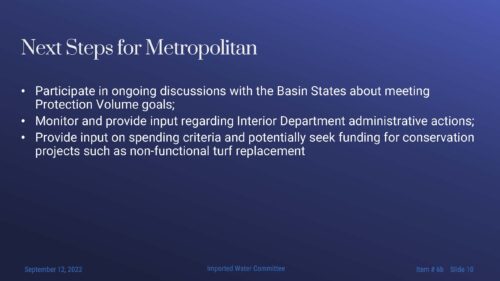 As for the next steps, Metropolitan staff will continue to participate in ongoing discussions with the basin states about meeting protection volume goals, monitor and provide input regarding Interior Department administrative actions, provide input on spending criteria and potentially seek funding for conservation projects, such as non-functional turf replacement.
As for the next steps, Metropolitan staff will continue to participate in ongoing discussions with the basin states about meeting protection volume goals, monitor and provide input regarding Interior Department administrative actions, provide input on spending criteria and potentially seek funding for conservation projects, such as non-functional turf replacement.
Discussion highlights
Director Russell Lefevre (Torrance) asked if beneficial use has a definition.
Ms. Rosset noted that beneficial use has a specific meaning in the context of Part 417, and it’s different than how the state defines beneficial uses. “It’s not as well defined, and the Interior Department may want it to be defensible if it is attacked in litigation,” she said. “I think that’s part of the reason why they’re considering taking additional administrative actions. In part, they may want to shore up those definitions through an administrative process.”
Director Tim Smith (San Diego) asked at what point can they no longer take supplies out of Lake Mead. Is there a trigger?
General manager Adel Hagekhalil said that when the level of Lake Mead gets to 1025, Metropolitan cannot access the storage but can keep it for complying with the Drought Contingency Plan. “We don’t want to get there because if you get there, you’re stuck with the storage you have. So that’s where the line is for me that will have a huge impact on all of us. When we can’t pull the storage out … we have over 1.3 million acre-feet of water in storage right now.”
Mr. Upadhyay agreed with Mr. Hadgekhalil, noting that there are layers of constraints that start to impact Metropolitan’s ability to have 1.1 million acre-feet or so in the Colorado River Aqueduct system. The first is the shortage declaration being at a level that affects Metropolitan, which was avoided by one tier for 2023. Had it been a tier lower, they would be making DCP contributions. So that does represent a bit of a constraint because it means that Metropolitan has to use the ICS stored in Lake Mead to make those DCP contributions. If the ICS runs out in the future, it will have more severe restrictions because Metropolitan would have to take other actions to reduce flows to comply with the DCP contribution. So he acknowledged there is some risk there.
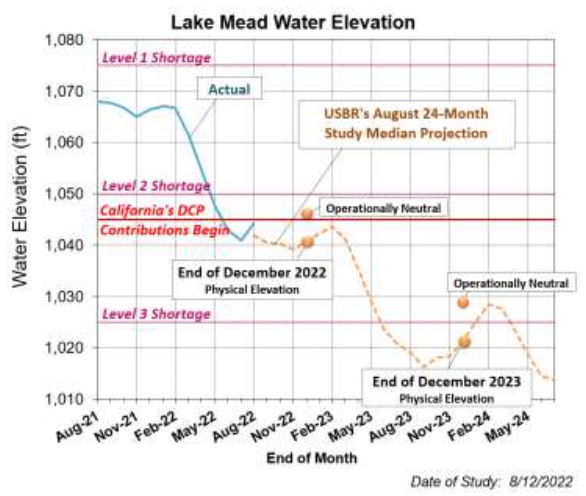 “The other thing that constrains us is the uncertainty around this process that Shanti described that the Bureau will go through,” Mr. Upadhyay said. “We want to negotiate contributions that we, as a state of California, can make with urban and the ag entities to reduce our use and for California to contribute to the solution on the river with reduced use. However, the backstop of not having a voluntarily negotiated structure but instead having the federal government come in and implement some of these reduction mechanisms could have adverse impacts on all of the contractors in the state of California, including Metropolitan. … So we should not assume that those outcomes of a beneficial use determination on the Bureau’s part somehow shields Metropolitan; we would likely be impacted also.”
“The other thing that constrains us is the uncertainty around this process that Shanti described that the Bureau will go through,” Mr. Upadhyay said. “We want to negotiate contributions that we, as a state of California, can make with urban and the ag entities to reduce our use and for California to contribute to the solution on the river with reduced use. However, the backstop of not having a voluntarily negotiated structure but instead having the federal government come in and implement some of these reduction mechanisms could have adverse impacts on all of the contractors in the state of California, including Metropolitan. … So we should not assume that those outcomes of a beneficial use determination on the Bureau’s part somehow shields Metropolitan; we would likely be impacted also.”
Director Smith then asked that when Arizona received federal money for the Central Arizona Project, wasn’t there an agreement that they would be the first one cut?
Mr. Upadhyay agreed, noting that it was a condition of getting the authorization and funding for the Central Arizona Project that Arizona would take the most junior priority in the lower basin. “The issue is that they’re going to be cutting 1.1 million acre-feet of their state’s allocation; the CAP is entitled to take 1.5 million acre-feet. So it gets a little sensitive to talk about a full cut back of that amount because there are tribal reserved rights that were settled through that CAP allocations, and there are a number of communities within the CAP service area that do not have an alternate source of water. And so even though they did agree to this, there are constraints on Arizona being able to cut back the full 1.5 million acre-feet.”
Ms. Rosset noted that from Arizona’s perspective, they have been offering to make additional cuts to meet the protection volume goals identified by the Commissioner that would exceed 1.5 million acre-feet. So from their perspective, they’re going to meet the spirit of that junior priority, but they can’t meet the goal of the 2-4 million acre-feet by themselves.
Director Randy Record (Eastern Municipal Water District) noted that Metropolitan has gone from importing 2 million acre-feet down to about 1.5, yet California’s population has grown dramatically. “We’ve increased our supplies by working with other agencies, conservation on IID following or PVID. So I think we can make a really good case that based on our allocation and all the growth that we’ve had, if you look at reducing reliance based on per capita usage, whether it’s Colorado River water or state project water, we’re meeting that goal.”
General manager Adel Hagekhalil noted that by Metropolitan putting a lot of water into the ICS, they propped up the levels in Lake Mead and delayed DCP contributions by Arizona by about five years of contributions of about 400,000 acre-feet or so. “It’s a number that we have to always put on the table as we negotiate, but many people don’t see that. So we have actually helped by putting a lot of ICS water in Lake Mead. I think we put an average of 50 feet over time. We’ve delayed this DCP cuts by over five years, and that five years did really provide Arizona a huge amount of relief from cuts.”
09122022 IW 6a Report

